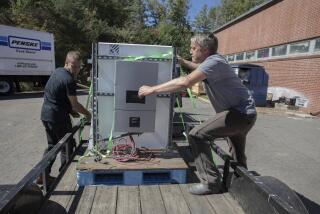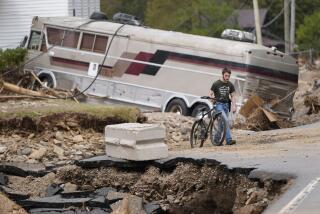East Begins Cleanup in Storm’s Path
RALEIGH, N.C. — Their neighborhoods in tatters but their resolve largely intact, residents of hurricane-battered areas turned Sunday to cleaning up formidable messes, watching swollen waterways and adjusting to life without electricity. At least six people were still reported missing.
Five electric utilities reported a total of 488,000 customers still without power. Water, and especially ice, remained crucial commodities, and lines formed at stores offering supplies--many free.
With many areas flooded with sewage-tainted water and thousands of trees on the ground, life was hardly returning to normal. But, on a muggy, torrid day, people ventured out with rakes and chain saws, and utility and municipal crews and private tree-clearing contractors plied the streets and back roads.
“We’re so sophisticated in this age of technology and science, but Mother Nature comes through and we’re back to 400 BC,” said Linda Daigle, clearing foliage from her lawn Sunday.
Hurricane Fran slammed into coastal North Carolina late Thursday and turned north, cutting a capricious swath of destruction as far inland as Raleigh and Winston-Salem before flooding Virginia and West Virginia with heavy rain.
The storm and its aftereffects killed at least 29 people, mostly as the result of falling trees, flooding and traffic accidents. The Federal Emergency Management Agency declared 34 North Carolina counties disaster areas.
A 60-member team on Topsail Island, in the hardest-hit coastal region, searched for five people reported missing, emergency officials said. One person was reported missing in Raleigh.
More flooding bore down on the coast Sunday. City streets in Wilmington were flooded again. State roads near the northeast Cape Fear River were reported submerged and impassable.
In Washington, the Potomac River gushed at 130 times its normal rate Sunday, overflowing its banks and destroying many of the repairs made to the C&O; Canal after another massive flood hit the area eight months ago. Major roads to downtown Washington and to National Airport were closed.
Meanwhile, Tropical Storm Hortense threatened flash floods and landslides on Puerto Rico and the U.S. and British Virgin Islands but had failed to reach hurricane strength, the National Hurricane Center said.
Hortense’s maximum sustained winds were 55 mph, down from 60 mph.
More to Read
Sign up for Essential California
The most important California stories and recommendations in your inbox every morning.
You may occasionally receive promotional content from the Los Angeles Times.









